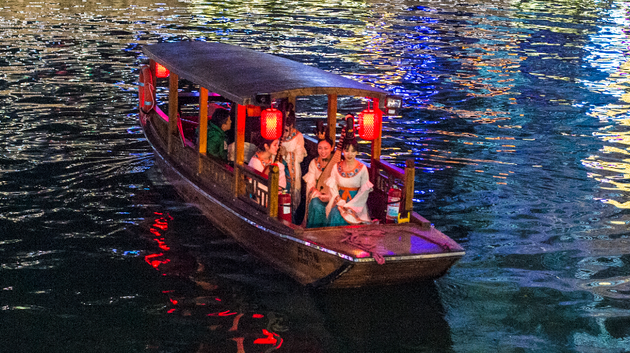
Girls in hanfu touring Jinjiang River in Chengdu at night (Photo/Dfic)
Mar. 18 (NBD) -- The Mogao Caves, a UNESCO world cultural heritage site located in Dunhuang vicinity, northwest China's Gansu province, will be opened to the public at night this year, in a move to attract more tourists, China News Service reported last week.
Beams of multicolored light last month illuminated the Palace Museum which offered first-ever night tours in celebration of the Chinese Lantern Festival. The ticketing system of the museum became overloaded over high night tour demand, and a scalped ticket was sold for as much as 3,000 yuan (447.2 U.S. dollars) online.
Also, during the Chinese Lunar New Year, cities held a variety of night-time events at their historic and cultural heritages or scenic spots, for instance, Beijing putting up a light show at the Palace Museum, Chengdu offering night tours along the Jinjiang River, and Xi'an holding "Datang Sleepless City" activities.
Incomplete statistics showed that over 10 cities launched night tours during the Chinese Spring Festival. Cities seem to start realizing the economic value harbored in the shades of evening. Leveraging cultural edges, the cities are setting eyes on economic benefits.
"Datang Sleepless City" attracted around 350,000 tourists on New Year's Eve and "Jinjiang River Night Tour" welcomed 166,000 visits.
Not a newly coined term, the evening economy generally refers to eating and drinking, entertainment, tourism and other activities taking place after people finish a day's work or formal education.
Xie Ling, managing director at Jones Lang LaSalle Chengdu, held that the night-time economy, as a new racing track for cities, has been evolving into a higher level, from focusing on single consumption mode to integrating and creating multi-component consumption scenarios. The latter becomes a new breach for cities in the new round of competition.
Beijing, one of the most active cities at night, stipulates in its work report 2019 that the city encourages major blocks, shopping malls, supermarkets and convenience stores to appropriately extend business hours, providing "midnight dinner" for people.
Chengdu, famous for nightlife, launched 12 night-time bus routes, increasing proportion of lines available from 22:00 to 1:00 O'clock the next morning to 32 percent.
The city situated in southwest China plans to explore new drivers for night-time consumption, step up fostering environment for the evening economy and build landmark of night-time consumption.
Xie noted that with the emergence of new consumption modes which integrate arts, cultural and creativity, sports events and museum exhibition, Chengdu is to form its competitive force.
Apart from ensuring infrastructure for the growth of the night-time economy, cities should also locate their exclusive characteristics and build distinguished elements.
The inheritance of traditional culture is very important, and how to avoid simple duplication and how to display local culture vividly should be taken into serious consideration, Xie stressed.
Taking Chengdu's "Jinjiang River Night Tour" for example, Xie said that to build an IP requires not only an international approach, but also a deep understanding and combination of connotation of local culture. Through introducing more new night-time economic types, the staying and consumption time of tourists will be prolonged, hence boosting consumption.
To grasp the opportunities of the evening economy and guarantee smooth running of night events, cities should enhance management, an industry insider pointed out.
Email: gaohan@nbd.com.cn


 川公网安备 51019002001991号
川公网安备 51019002001991号





